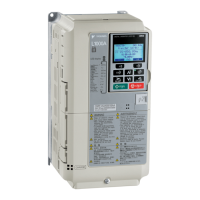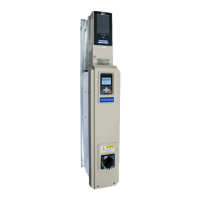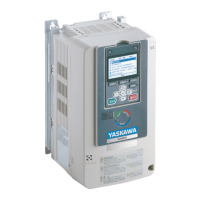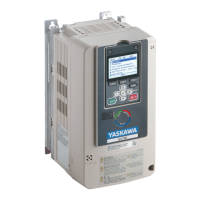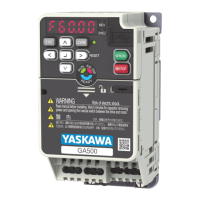Parameter Details
12
12.2 b: Application
YASKAWA SIEPYEULA5001C LA500 Technical Manual 285
Note:
Refer to this table for Drive Mode and Programming Mode functions.
Mode Keypad Screen Function
Drive Mode Monitors
Sets monitor display.
Programming Mode
Parameters
Changes parameter settings.
User Custom Parameters
Shows the User Parameters.
Parameter Backup/Restore
Saves parameters to the keypad as backup.
Modified Parameters/Fault Log
Shows modified parameters and fault history.
Auto-Tuning
Auto-Tunes the drive.
Initial Setup
Changes initial settings.
Diagnostic Tools
Sets data logs and backlight.
0 : Disregard RUN while Programming
The drive does not accept the Up/Down command when setting the parameters in the Programming Mode.
1 : Accept RUN while Programming
The drive accepts a Up/Down command entered from an external source when setting the parameters in
Programming Mode.
■ b1-14: Phase Order Selection
No.
(Hex.)
Name Description
Default
(Range)
b1-14
(01C3)
Phase Order Selection
Sets the phase order for output terminals U/T1, V/T2, and W/T3. This parameter can align the
Forward Run command from the drive and the forward direction of the motor without changing
wiring.
0
(0, 1)
0 : Standard
1 : Switch Phase Order
◆ b4: Timer Function
The drive uses timers to delay activating and deactivating MFDO terminals.
Timers prevent sensors and switches from making chattering noise.
There are two types of timers:
• Timers that set a delay for timer inputs and timer outputs.
These timers delay activating and deactivating of the MFDIs and MFDOs.
To enable this function, set H1-xx = 18 [MFDI Function Selection = Timer Function], and set H2-01 to H2-03
= 12 [MFDO Function Selection = Timer Output].
• Timers that set a delay to activate and deactivate MFDO terminals.
These timers delay activating and deactivating MFDO terminals.
To enable this function, set delay times in parameters b4-03 to b4-08.
■ Timer Function Operation
• Timers that Set a Delay for Timer Inputs and Timer Outputs
Triggers timer output if the timer input is active for longer than the time set in b4-01 [Timer Function ON-Delay
Time]. Triggers timer output late for the time set in b4-02 [Timer Function OFF-Delay Time]. Figure 12.1
shows an example of how the timer function works.
Figure 12.1 Example of Timer Function Operation

